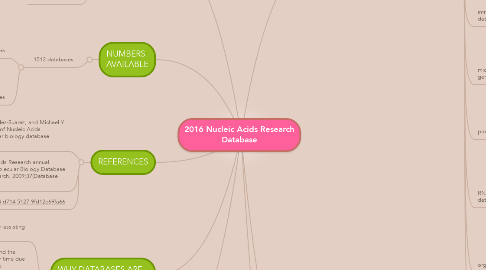2016 Nucleic Acids Research Database
by Iffah Ramle

1. GROUP 5 MEMBERS
1.1. AININ SOFEA BINTI MUHAMAD TAUFI
1.2. AISYAH HAMINAH BINTI AZHAR
1.3. HAZIRAH BT MOHD ASANDI
1.4. NURUL IFFAH NADHIRAH RAMLE
1.5. SITI HALILAH BTE NORDIN
2. ORGANISATION OF DATABASES AND ITS MAJOR GROUPING
2.1. nucleic acid sequence databases
2.1.1. 3D-footprint
2.1.2. ABS
2.1.3. ACLAME
2.2. protein sequence databases
2.2.1. 3DSwap
2.2.2. AAindex
2.2.3. ABCdD
2.3. structure databases
2.3.1. 2P2Idb
2.3.2. 3DNALandscape
2.3.3. Glycan
2.4. metabolic and signaling pathways databases
2.4.1. 3D-interlogs
2.4.2. AgingChart
2.4.3. Allosteric Database
2.5. genomic databases (non-vertebrate)
2.5.1. ACeDB
2.5.2. AlterORF
2.5.3. AmoebaDB
2.6. Human and other veterbrate genome
2.6.1. AgBase
2.6.2. Evola
2.6.3. ENCODE DCC
2.7. human diseases and drugs databases
2.7.1. CancerResource
2.7.2. ADHDgene
2.7.3. Cancer3D
2.8. plants databases
2.8.1. AgBase
2.8.2. AGRIS
2.8.3. CottonGen
2.9. immunological databases
2.9.1. ALPSbase
2.9.2. AntiJen
2.9.3. DIGIT
2.10. microarray data and other gene epression databases
2.10.1. 4DXpress
2.10.2. ABA-Ascidian Body Atlas
2.10.3. Allen Brain Atlas
2.11. proteomic databases
2.11.1. 2D-Page
2.11.2. AAindex
2.11.3. BIOZON
2.12. RNA sequence databases
2.12.1. 16s and 23s Ribosomal RNA mutation
2.12.2. 3D rRNA modification maps
2.12.3. 5s Ribsomal RNA Database
2.13. organelle databases
2.13.1. Chloroplast Genome Databases
2.13.2. FUGOID
2.13.3. GOBASE
2.14. other molecular biology databases
2.14.1. HyperCLDB
2.14.2. BioModels
2.14.3. WormBook
3. NUMBERS AVAILABLE
3.1. 1512 databases
3.1.1. 178 papers
3.1.1.1. 62 newly described databases
3.1.1.2. 95 updates on older databases
3.1.1.3. 17 updates on previously described elsewhere
3.1.2. 15 categories
3.1.2.1. 41 sub-categories
4. CRITERIA FOR SELECTION INTO NAR DATABASES
4.1. possesses uniqueness: not to have been described elsewhere
4.2. ‘boutique’ databases; covering relatively narrow topics
4.3. degree of value added (usually in the form of manual curation) in the production of the database
4.4. comprehensiveness of coverage
4.5. general utility of the database to the scientific community
4.6. usefulness of the database to the community
4.7. longevity and sustainable value
5. REFERENCES
5.1. Daniel J. Rigden, Xosé M. Fernández-Suárez, and Michael Y. Galperin The 2016 database issue of Nucleic Acids Research and an updated molecular biology database collection
5.2. Galperin MY, Cochrane GR. Nucleic Acids Research annual Database Issue and the NAR online Molecular Biology Database Collection in 2009. Nucleic Acids Research. 2009;37(Database issue):D1-D4. doi:10.1093/nar/gkn942.
5.3. https://www.pharmacoepi.org/pub/1c2a306e-2354-d714-5127-9fd12e69fa66
6. WHY WE NEED TO GROUP THESE DATABASES
6.1. to smooth the process of attaining the materials
6.2. provide the specific results of searches
6.3. due to the massive increase in information, sorting out is compulsory
6.4. manipulate the information in effective ways to save times, cost and energy
6.5. help in gaining better understanding of research
6.6. provides "table of content" to briskly access the materials
7. WHY DATABASES ARE CREATED AND SHARED
7.1. important tools in assisting researchers
7.2. to make sure that informations will develop faster and the problems such as diseases, will be solved in shorter time due to the latest informations are shared between all the researchers
7.3. to keep in track about latest informations
7.4. to trace the invalid informations
8. WHY SOME DATABASES ARE NO LONGER IN THE THE DATABASES AND DROPPED FROM IT
8.1. has turned obsolute
8.2. not valid due to the lack of latest information

